Imagine a means of transport that does not need fuel, electricity or even hydrogen. The key lies in an energy that comes from space and that the first solar car has managed to make the most of. Find out how road mobility will evolve and how we are going to close both petrol and petrol stations (and hydropower stations, if they ever open).
Lightyear, the car that uses no fuel and would run even on Mars
The Lightyear car represents a bold vision from a team of engineers in the Netherlands seeking to revolutionize electric mobility. Lightyear is a startup founded in 2016 with the ambitious goal of developing long-range solar electric vehicles.
The company takes its name from the character Buzz Lightyear in Toy Story, aiming to “go to infinity and beyond” by pushing the boundaries of solar EV technology. Lightyear’s motto is “driving on sunshine,” reflecting their ideals of sustainable transportation powered by the sun’s energy.
The Lightyear One, unveiled in 2019, is the company’s first model – a sleek, aerodynamic sedan covered in solar panels. Through lightweight design and an energy-efficient drivetrain, the Lightyear One can potentially travel up to 450 miles on a single battery charge.
The integrated solar panels provide additional range from sunlight up to 40 miles per day. Lightyear aims to prove that solar-assisted electric cars can offer practicality for daily driving without compromise.
Lightyear solar car at a glance: why it’s a success
One of the most unique aspects of the Lightyear is its solar panels. These solar panels are spread across the roof and hood of the car, allowing it to passively charge the battery through sunlight.
Lightyear claims that the solar panels can add over 40 miles of range per day under ideal conditions. This essentially gives the car “unlimited” range, as long as there is sunlight. Even on cloudier days, the solar panels still contribute extra range.
In total, the Lightyear One model has a maximum WLTP-certified range of 388 miles on a full charge. The solar panels give it an edge over other EVs in terms of energy efficiency and total possible range.
Lightyear focused heavily on aerodynamic design to maximize the solar panels’ efficiency. The car has a very sleek, rounded profile to reduce drag. This helps it cut through the air using less energy, boosting overall range.
Lightyear claims the car has a very low drag coefficient of 0.175 Cd. The Tesla Model 3 has a drag coefficient of 0.23 Cd. The optimized aerodynamic shape lets the Lightyear car go farther on the same battery capacity.
It’s not all good news: the solar car is going through a difficult time in production.
The Lightyear One faces significant challenges when it comes to production. Firstly, the high cost of production has made it difficult to manufacture solar vehicles profitably. Each Lightyear One costs around $170,000 to produce, far above the company’s target sales price of $149,000.
Secondly, Lightyear filed for bankruptcy in November 2022, shortly after starting production. The company cited “difficult market circumstances” as the reason for seeking creditor protection. The bankruptcy filing casts uncertainty over Lightyear’s future and ability to fulfill customer pre-orders.
Finally, Lightyear originally planned to manufacture 946 units of the Lightyear One. However, after the bankruptcy, it cut production to just 150 vehicles for 2023. This limited production run reflects the company’s precarious financial situation. It also means the car will not achieve economies of scale that could help reduce costs.
As you can see, the first solar car in history has everything to succeed, even if the company is not going through its best moment in terms of profitability. They have managed to innovate so much that it would even work on Mars, although what matters to us is how it does here on Earth. So far, they have not been able to compete with Tesla, which is expected to be tough.

